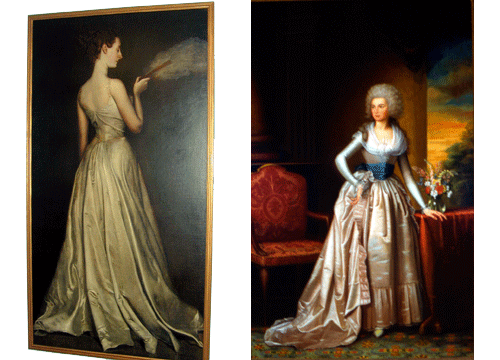
Since late spring, the curatorial staff has been working diligently on plans for the upcoming exhibition Face Lift: The Power of Portraits. Portraiture is one of the oldest and most popular forms of artistic expression and anyone familiar with the Gibbes knows it boasts of a particularly prominent collection of American portraiture. For this exhibition we set out to delve deep into the collection with the goal to bring forth the magnificent stories our diverse portraiture collection tells.
Our quest to select works for the exhibition began with numerous, thorough searches of our collection database. The database contains vital information and an image for each of the nearly 7000 works of art housed at the Gibbes, and is a valuable tool for narrowing the field of options. Next, we decided to display works together in pairs. Juxtaposing the portraits in this way draws attention to notable elements such as pose, costume, size, and props that together, reveal a story beyond a portrait’s primary purpose of documenting the likeness of the individual. Naturally a number of striking portraits stood out as fascinating comparisons. For instance, we found the full-length portraits of Madame Pierre Gautreau, painted by Antonio de la Gandara in 1897, and Mary Motte Alston, painted by Edward Savage in 1792 captivating in both composition and in the context of the very different lives these two women led. In their portraits Mme. Gautreau and Mrs. Alston pose facing opposite directions, and the women themselves were indeed contrary to one another.
Virginie Avegno Gautreau is perhaps better known as the infamous “Madame X,” the name bestowed upon a portrait of her by John Singer Sargent (1856–1925) exhibited at the Paris Salon of 1884. Originally from Louisiana, Virginie Avegno and her family moved to Paris after the Civil War. There she married the wealthy Parisian, Pierre Gautreau. Well known for her startling beauty and expensive tastes, many Parisian women resented Mme. Gautreau’s social prominence. So, when Sargent’s scandalous portrait was exhibited, Paris’s social elite ostracized her. Mme. Gautreau spent the rest of her life trying to repair her reputation by commissioning new portraits of herself. Antonio de la Gandara often painted society women and celebrities, and was receptive to Mme. Gautreau’s needs. In his portrait, Mme. Gautreau conveys that age has brought her a modest elegance, but still she retains her supple physique, arresting profile, and coquettish nature.
In contrast, Mrs. Alston does not use a fan, strappy dress, or languid pose to draw attention to her beauty. Her priorities are markedly different from Mme. Gautreau’s conceptions of social status and physical appearance. Her defiantly assertive pose looking out from the canvas denotes this difference from Mme. Gautreau’s world of self-absorption. A Charleston native, Mrs. Alston was the wife of a wealthy plantation owner, yet she possessed deep compassion for the poor and sick surrounding her, and was known to frequently bring food and clothing to those in distress. She was also strong proponent of self-improvement through education and deplored idleness. In a letter to her fifteen year-old daughter, she wrote, “I have written to Mrs. Kershaw to give you $15 which I beg you not to spend foolishly and get four bonnets as you did last summer, but get useful things.” Imagine what Mrs. Alston would say to Mme. Gautreau!
Face Lift: The Power of Portraiture opens September 3 in the Main Gallery and will feature fourteen portrait pairings, each revealing portraiture’s remarkable capacity for storytelling. See a list of current and upcoming exhibitions.
—Sara Arnold, Curator of Collections, Gibbes Museum of Art
Published August 30, 2010

